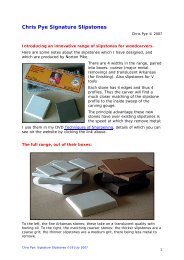Joiner and - Tools for Working Wood
Joiner and - Tools for Working Wood
Joiner and - Tools for Working Wood
Create successful ePaper yourself
Turn your PDF publications into a flip-book with our unique Google optimized e-Paper software.
The disadvantage of this shallow rabbet is that you need an extra tool<br />
(a fillister plane) <strong>and</strong> it adds another step. I do a lot of dovetailing <strong>and</strong><br />
have found the extra step is well worth my time – it saves time in lining<br />
up my boards.<br />
Next up is sawing the first half of the joint. Thomas cuts his pins<br />
first, so let’s explore that method. The layout of his joint is interesting.<br />
Thomas spaces his dovetails so there is 1/8" between the joints at the<br />
narrow end <strong>and</strong> 1/4" between the joints at the baseline. That translates<br />
to a slope of about 4.8° – that’s fairly shallow.<br />
And because the slope of the dovetail vexes so many, let’s take a look<br />
at this topic <strong>and</strong> the advice that is both modern <strong>and</strong> vintage.<br />
I’ve seen this joint cut with a wide variety of slopes. And every<br />
person who cuts this joint has a personal or historical preference about<br />
the slope they use. For some craftsmen, the slope varies simply because<br />
they eyeball the layout. Frank Klausz, one of the two living dovetail<br />
<br />
off the vertical. The late Tage Frid preferred slopes of “about 10°.”<br />
Other well-known dovetailers use marking jigs to lay out the joint,<br />
which locks them into particular angles. Rob Cosman, the other living<br />
<br />
For all the years I’ve been cutting dovetails, I’ve used the angles used by<br />
<br />
Cosman. But <strong>for</strong> some reason, I’ve become dissatisfied with the way the<br />
joints look when they are visible on a piece of casework.<br />
So I hit my library, <strong>and</strong> now my head hurts from the bludgeoning.<br />
Dovetails might take their name from a bird, but reading about them is a<br />
trip down the rabbit hole.<br />
<br />
To underst<strong>and</strong> how little that is certain with dovetails, let’s take an<br />
abbreviated journey through the literature. I promise to be quick like<br />
a bunny. Charles H. Hayward, the mid-20th-century pope of h<strong>and</strong>-cut<br />
joinery, suggests three slopes: Use 12° <strong>for</strong> coarse work. Use 10° or 7° <strong>for</strong><br />
decorative dovetails. There is no advice on hardwoods vs. softwoods.<br />
<br />
<br />
“Audel’s Carpenter’s Guide,” an early 20th-century technical manual,<br />
<br />
No advice on hardwoods vs. softwoods. “Modern Practical <strong>Joiner</strong>y,” the













